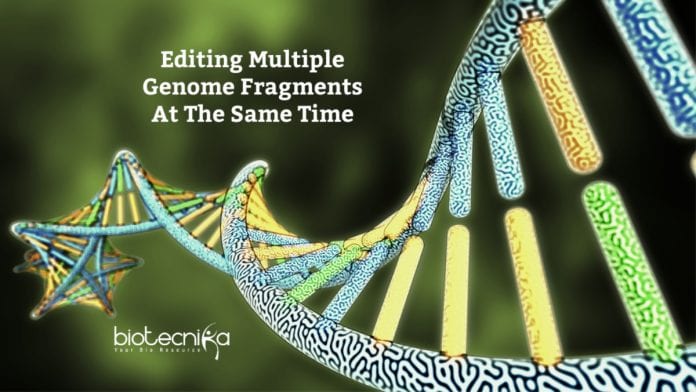Editing Multiple Genome Fragments At A Time
Multiple sites in the genome can now be edited at the same time, which enables scientists to understand how different stretches of DNA cooperate in the contexts of both disease and normal physiology, health.
The study of the human genome has been revolutionized by CRISPR-based DNA editing as it allows precise deletion of any human gene to obtain information about its functions. However, the ability to remove multiple genes or gene fragments simultaneously in the same cell remained a challenge.
The CHyMErA system
Thanks to the two professors of molecular genetics at the Donnelly Centre for Cellular and Biomolecular Research, the teams of Benjamin Blencowe and Jason Moffat have now developed such a tool. The tool, a new system called ‘CHyMErA’ which stands for Cas Hybrid for Multiplexed Editing and Screening Applications was developed. This method can be applied to systematically target the DNA at multiple positions at the same time in any type of mammalian cell, which makes editing multiple genome fragments at a time possible.
Cas9 is the DNA-cutting enzyme that is most widely used. Scientists have been seeking to expand and improve the CRISPR technology applications by identifying other Cas
enzymes with distinct properties since Cas9 first came to light. CHyMErA combines Cas9 and Cas12a, two different DNA-cutting enzymes to allow more versatile applications, unlike the CRISPR-Cas9 technology. The key for simultaneous DNA editing is achieved by the Cas12a enzyme, which can be used to generate multiple guide RNA molecules in the same cell.A research associate in Blencowe’s group, Thomas Gonatopoulos-Pournatzis had spent many years trying to develop combinational gene editing by testing Cas12a and Cas9 enzymes on their own and then, he had the idea to create the CHyMErA system by combining these enzymes.
He says, “Nothing worked as good as CHyMErA after we had tried a number of approaches to induce genetic fragment deletions. Looking at the first evidence that CHyMErA was successful in deleting gene segments, me and a Ph.D. student in the Blencowe lab, Shaghayegh Farhangmehr, were thrilled!”
Systematically analyzing how genes act together and analyzing the functions of individual parts of genes was the next step to harness CHyMErA in large-scale screens. Moffat, a group who had developed extensive experience with CRISPR technology were approached by Blencowe’s team, which studies the regulation and function of gene segments known as exons.
Playing a key role in developing the screen-based applications of CHyMErA, a research associate in the Moffat lab, Michael Aregger said, “You can use the best of the two enzymes with the CHyMErA system.”
Pairs of genes knowns as paralogs, which have a similar DNA code but were difficult to research being poorly studied, were also targeted by the researchers in one application of CHyMErA.
A senior research associate in the Moffat lab and co-lead author on the study, Kevin Brown said, “We can take out both paralogs in pairs to see if that ancestral function is important for the cell to survive using CHyMErA. A class of genes that were previously missed can be interrogated now.”
After ~700 paralog pairs were knocked out, it was confirmed by the analysis that many of these gene pairs perform similar roles in cell survival while others have distinct functions.
To cut out gene fragments such as exons, both Cas9 and Cas12a can be deployed to nearby genome sites, which is another feature of CHyMErA. A huge number of exons that have been linked to brain function and cancer could be deleted individually. CHyMErA analyzed around 2,000 exons out of which over 100 were found to be critical for cell survival, which enables future research.
Gonatopoulos-Pournatzis says, “New therapies can be developed using the information we get once we identify exons that have a critical role in disease.”
The journal Nature Biotechnology published this research study.






























